

The PGA Tour’s Rising Driver Ball Speeds Mean One Thing – $$
Written by Graeme Hay | Last Updated: 25/06/2024

In modern golf it seems you can’t watch a PGA event on TV these days without the commentary quickly turning to the subject of distance and especially driver distance.
And because ball speed is the single biggest factor in determining the distance a golf ball actually carries the ball speeds of the top pros are consistently flashed on the screen as they smash their latest tee shot.
So given the importance of ball speed in golf today we thought it was time to take a look at the average driver ball speeds on the PGA Tour.
The average driver ball speed on the PGA Tour is 172.72mph according to the latest Shotlink stats. This represents a 0.86mph rise on the Tour average of 171.86mph at the end of the 2022 season and is 7.36mph more than the 165.36mph PGA Tour average recorded in 2007 when Shotlink began to track this metric.
But when you delve a bit deeper into the ball speed numbers amongst the top PGA and LPGA Tour pros the pattern that emerges is fascinating and the reason why the best athletes – for that is what they are now – are now constantly searching for ever more ball speed is laid bare.
And what is more, it seems absolutely clear that this quest for more ball speed amongst the top pros is not going to stop any time soon!
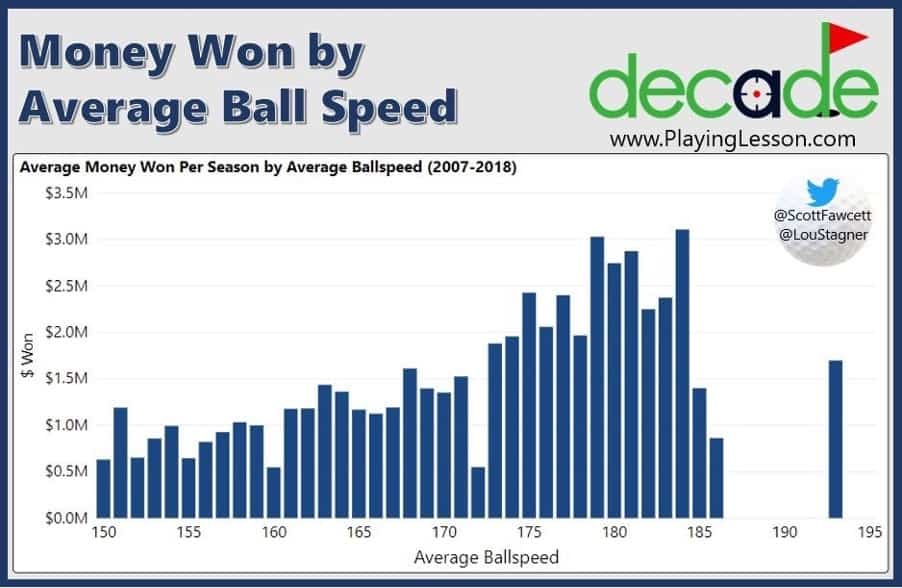
More Ball Speed on the PGA Tour = More Distance = More Money!
When a trend is seen in any sport, and especially when money is involved, the obvious question that follows is what is the reason behind it.
As we have already noted the average ball speed on the PGA Tour has been steadily rising over the last number of years, and continues to do so, therefore it is safe to assume that given there are millions of dollars in prize money at stake that there is a good reason why this is the case.
Some may point to the fact that based on the average numbers we have highlighted, ball speeds have only increased by a seemingly minor 0.49mph per year from 2007 until 2022, but while this is indeed a small number, it makes a big big difference to PGA Tour players.
Pro tip : Ball speed is the single biggest factor in how far a golf ball ‘ actually ‘ carries and is not to be confused with club/swing speed which is the key factor for determining a golfer’s ‘ potential ‘ distance. Ball speed is often judged by ‘smash factor’ which is calculated by dividing ball speed by club/swing speed. The closer the smash factor to the perfect score of 1.5 the better the energy transfer from the club to the ball.
And the simple reason for that is that more ball speed means more distance.
And more distance has been clearly identified by the golf stats gurus as a crucial element in the difference between the scores of all standards of golfers including the best pros in the world.
As Professor Mark Broadie, the godfather of modern golf stats, is quoted as saying – “Golfers who can’t hit it long and straight never even make it to the tour. You need to drive the ball longer than 280 yards to have any chance of competing on the PGA Tour.”
So for all the talk in traditional golf circles of how you drive for show but putt for dough the hard reality amongst elite golfers on the PGA Tour, or any professional golf tour for that matter, is that you have to hit the ball a long way to succeed.
Therefore given a gain of 1mph of ball speed can increase a drive distance by up to 2 yards according to Trackman – and that for pros an extra 20 yards of driving distance is worth about three-quarters of a stroke per round – it is immediately apparent why they keep focusing on improving their driver ball speed number.
3/4 of a stroke per round may not sound very much but for a PGA Tour pro it could mean hundreds of thousands if not millions of dollars in increased prize money.
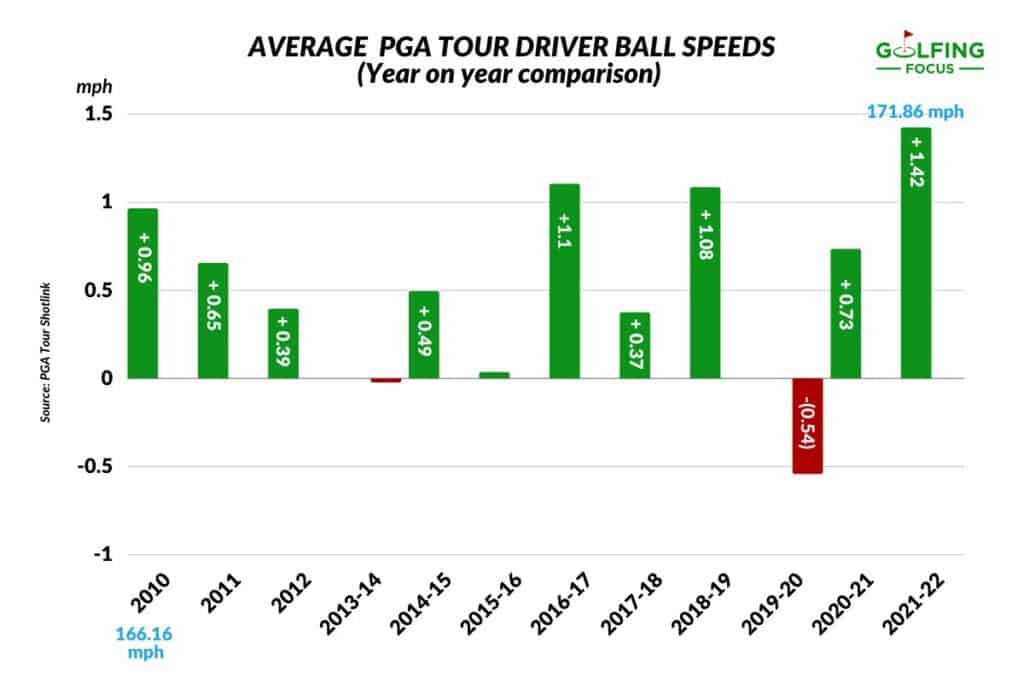
In 2022 for example Cameron Young was 10th on the money list with over $6.5 million in prize money and a scoring average of 69.84. Adam Hadwin’s scoring average by comparison was 70.59 which left him 49th on the list and take home money of just over $2.5 million.
Or to look at it another way that 3/4 (0.75) of a stroke difference over the course of the season cost Adam Hadwin around $4 million!
Not that we should feel too bad for pro golfers who earn millions of dollars but the key point to take away is simply this.
On the PGA Tour more ball speed equals more distance which in turn means more prize money.
Being amongst the top PGA Tour pros in terms of driver ball speed is therefore obviously vital to success and now all the best players in the world are clearly aware of this they are going to continue to push the boundaries to achieve more and more ball speed with their driver.
And just to emphasize how much PGA Tour pros are now focused on driver ball speed you need only look at the number of them averaging a driver ball speed of 170mph on tour over the years which is something that used to put pros into the elite.
Today it’s not even average and as we can see from the table below it’s a ball speed that will more than likely cost a PGA pro his place on the tour!
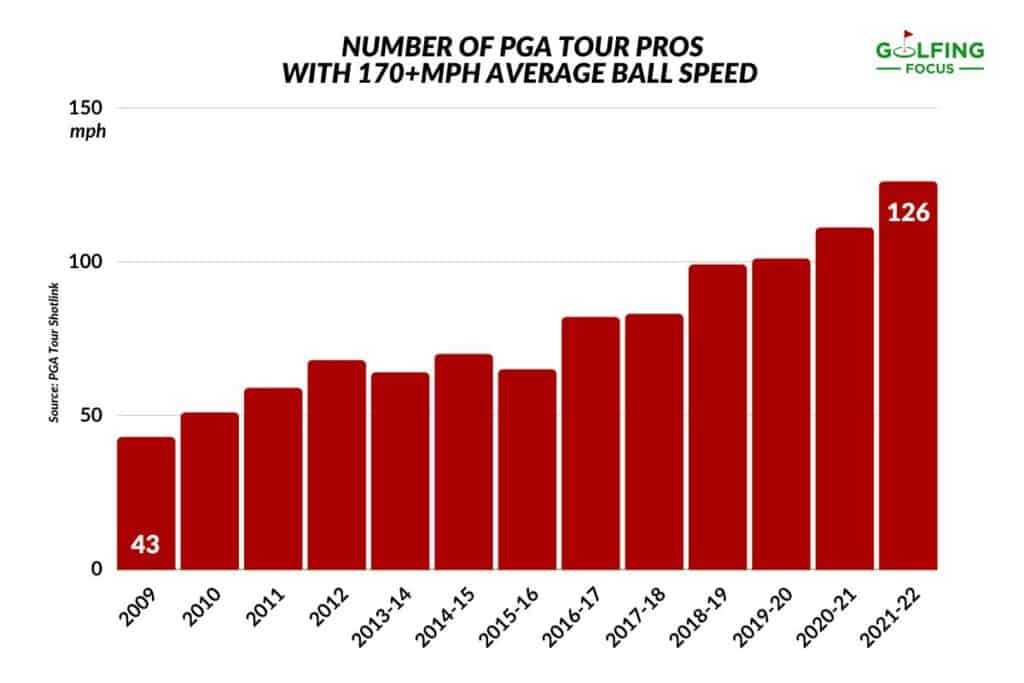
[Note – If you are interested in our delve into the topic of how far amateur driver ball speeds should go ranging from 100mph and up check out our other top article here .]
What is the Fastest Driver Ball Speed on the PGA Tour?
Although average driver speeds are all very well when it comes to talking about anything to do with speed people quickly want to know who is the fastest.
And with driver ball speed on the PGA Tour golfers are no different.
The fastest ‘average’ PGA Tour driver ball speed is 190.94mph and was set by Cameron Champ over the 2020-21 season. The fastest ‘individual’ ball speed on tour of 199.55mph was recorded by Bryson DeChambeau again in 2020-21 but DeChambeau has reached a ball speed of 219mph in world long drive championship competition.
A quick glance through the fastest driver ball speeds on the PGA Tour since 2007 reads like a who’s who of the long drivers in the world of golf in recent times but even these supremely fast numbers almost pale into insignificance when we take a look at the ball speeds of the long drive specialists.
Two-time World Long Drive champion Kyle Berkshire, who unbelievably has hit a drive in competition that almost reached the 500-yard mark (yup, you read that right!), broke the Trackman ball-speed record with an astonishing 236.2mph hit in December 2022.
And unbelievably since that time that record has been broken not once but twice!
Firstly by Berkshire himself at the end of March 2023 with a recorded ball speed of 236.8mph but then again by reigning World Long Drive champ – Martin Borgmeier – who smashed a new world record ball speed of 239.3mph at the beginning of April 2023.
Putting that into context that is an average ball speed roughly 50mph faster than Rory McIlroy’s average on tour, over 53mph more than Jon Rahm’s and almost 59mph faster than Justin Thomas’.
What should be noted though is that compared to the long-driving specialists like Kyle Berkshire the pros on the PGA Tour are more than likely not hitting their drives at top speed when you watch them play tournaments.
To maintain control they will often dial back from what they could achieve should they really go for it with driver and focus purely on achieving the highest ball speed number they can while not worrying at all about where the ball goes.
So when you next watch your favourite players on TV just bear in mind that as Jon Rahm ably demonstrates in the clip below they more than likely have more in the tank!
Rahm is a beast 127.8mph club head speed 188.2mph ball speed That speed with that backswing length is incredible Really cool to see more videos of what players have in the tank vs what they use on the course. Give Rahm a few goes and he’s over 130mph easy. pic.twitter.com/4UlP06CYxt — Fit For Golf – Mike Carroll (@Fit_For_Golf) March 2, 2023
And what about the great Tiger Woods?
You would think that following his serious car crash in early 2021, in the aftermath of which it looked possible he could lose his leg, that a modern game focused on ever-increasing ball speed would now simply get away from him.
And especially when you consider that in the last event he played in prior to the accident, the 2020 Zozo Championship, he averaged a mere 168.5mph driver ball speed and reached a maximum of 171mph.
Unbelievably however in the first round of the 2023 Genesis Invitational at the Riviera Country Club in California, Woods produced an average driver ball speed of 177.6mph, hitting a max of 180mph on not one but two occasions.
Set against the current PGA Tour ball speed average of 172.72mph it seems arguably the greatest golfer ever to play the game is not going to let the younger generation leave him in the slow lane of ball speeds quite yet!
[Note – To find out how the best pros in the world hit the ball so far check out our detailed analysis on this topic here .]

What About the Average LPGA Tour Driver Ball Speed?
When it comes to the professional game the talk is typically dominated by the men’s game.
However when we turn our attention to the LPGA Tour we can quickly see that when it comes to driving distance and the speeds associated with making that happen the same trend can be seen amongst the best women golfers in the world.
Since the great Laura Davies topped the LPGA Tour driving chart in 1993 with an average distance of close to 255 yards, Emily Pedersen has added another 30 yards to that mark 20 years later.
And that means driver ball speeds have been rising on the LPGA Tour also.
The average driver ball speed on the LPGA Tour is now 140mph according to Trackman. World No.1 Lydia Ko averages this speed while longer hitters including Nelly Korda produce ball speeds over 150mph. The longest driver in 2022, Maria Fassi, records ball speeds of 156mph on average.
While these numbers are well short of their male counterparts they show the best women pros are equally focused on distance and driving up their ball speed numbers.
And given the similarity in swing speeds also between the average male golfer and LPGA Tour pros it would often serve regular players far better to see what they can learn from the top pros on the LPGA Tour versus the PGA Tour.
While the average male amateur averages around 219 yards with their driver LPGA Tour pros average a total driver distance of 257 yards with an almost identical club/swingspeed.
That’s an enormous difference of 38 yards and is evidenced clearly by the better ball speeds the top women pros achieve based on their superior ball striking compared to regular amateurs.
So if you’re a regular male amateur player and looking at ball speeds you should probably be comparing yourself against the ball speeds produced by LPGA Tour pros, a selection of whose speeds are detailed on the table below.
More great articles related to this topic:
- How Do Pros Hit the Ball So Far? It’s Not About the Equipment!
- How Often Do Pros Hit Driver? Not As Much As You Think!
- How Far Do Pro Golfers Hit Each Club?
- What Driver is Most Used On the PGA Tour? Top 100 Player Analysis
- Driving Success – The Most Popular Driver On LPGA Tour
- How Far Should You Hit a Driver? FULL GUIDE By Age, Handicap etc.
- Should Beginners & High Handicappers Use a Driver? Yes & Yes
- Going the Distance? How Far Should Beginners Hit A Golf Ball?
- How Far Should I Hit My Hybrids? 2 vs 3 vs 4 Hybrid Distances
- How Far Does a 3 Wood vs 5 Wood Go? Tee and Approach Shots!
- Do Distance Golf Balls Go Further? Marketing Matters
- Do All Golf Balls Go the Same Distance? Physics First
- Are Driving Range Distances Accurate? Golf Balls are a Problem
- How Far Should Your Ball Speed Go? 100mph All the Way to 210mph!
- What Should Your Driver Attack Angle Be? Try Not to Be Negative
Leave a Reply Cancel reply
Your email address will not be published. Required fields are marked *
Save my name, email, and website in this browser for the next time I comment.
RECENT ARTICLES

Driving Success – The Most Popular Driver on LPGA Tour (2024 update)

Perfecting the Approach: The Most Popular Irons on LPGA Tour (2024)

What Golf Balls Do LPGA Players Use? They’re Not Very Lady Like! (2024 update)

Behind Every Stroke: The Most Popular Putter on Champions Tour (2024)

Champions Hybrid Heroes. Most Used Hybrids by Champions Tour Pros (2024)
LEGAL INFORMATION
This site is owned and operated by Golfing Focus Limited, a private limited company whose registered office is in London, UK. Golfing Focus Limited is a participant in the Amazon Services LLC Associates Program, an affiliate advertising program designed to provide a means for sites to earn advertising fees (at no cost to you) by linking to Amazon.com. Golfing Focus Limited also participates in other affiliate programs with the eBay Partner Network, FlexOffers, CJ.com, Svorn and other sites and is compensated for referring traffic and business to these companies (again at no cost to you).
Our Socials

Which golfer has the fastest average ball speed?
By steve coulter • published july 15, 2022 • updated on july 15, 2022 at 4:07 pm.
At 157.57 miles per hour, even the “slowest” ball striker on the PGA Tour has an average speed that’s significantly faster than Novak Djokovic’s average speed serve at 2022 Wimbledon and the maximum exit velocity of Aaron Judge’s hardest-hit career home run.
The distinction of softest hit golf ball – on average – belongs to Brendon Todd. Not exactly a household name, at least compared to the likes of Djokovic and Judge.
Going up the PGA’s list of ball speed off the tee, the names start to look more familiar (like Rory McIlroy who sits at No. 9) – and the average speeds are even more wild considering how they soar over other top athletes.
Stay in the game with the latest updates on your beloved Chicago sports teams! Sign up here for our All Access Daily newsletter.
Let’s take a look at some of the best golfers in the world and determine who owns the distinction for fastest ball speed on the PGA Tour and how fast the ball averages off the tee.
What is the average ball speed on the PGA Tour?
The average ball speed on tour is 171.65 miles per hour, through the 2022 Genesis Scottish Open.
Who hit the fastest golf ball in 2022?

Amy Yang wins Women's PGA Championship for her first major title
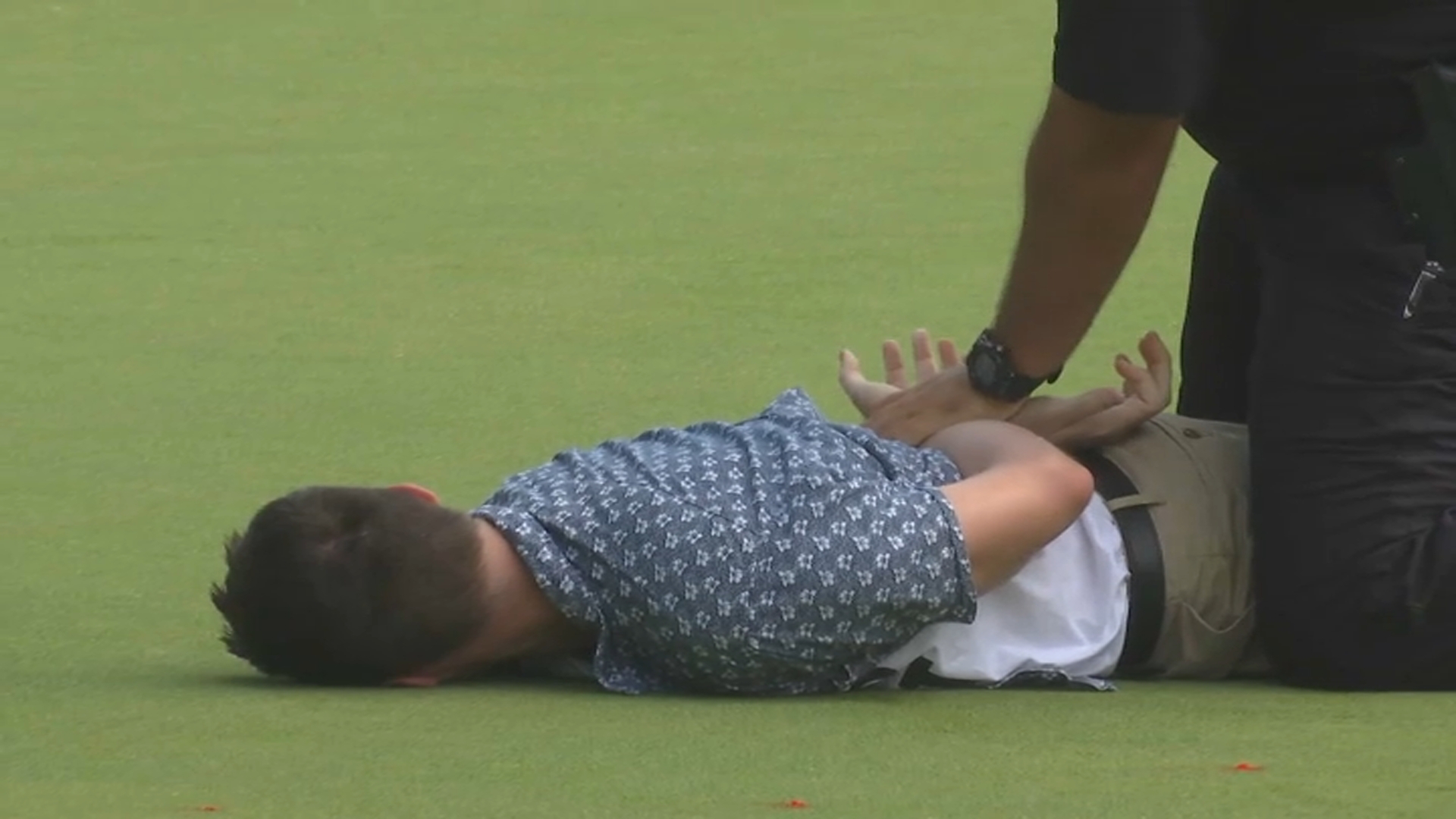
Protesters storm the 18th green at Travelers Championship
Peter Uihlein has the fastest ball speed off the tee this year with 195.13 miles per hour.
Who has the fastest ball speed on the PGA?
Cameron Champ averages 188.85 ball speed off the tee and currently leads the PGA in ball speed.
What is Rory McIlroy's average ball speed?
Rory McIlroy is averaging 182.98 miles per hour off the tee in 2022, good for ninth overall on the PGA Tour.
What is Rory’s fastest ball off the tee in 2022?
Rory has registered a ball that went 190.59 miles per hour off the tee. His slowest shot was 167.82.
What is Dustin Johnson's ball speed?
Dustin Johnson currently averages 177.77 miles per hour for ball speed off the tee, good for 36th on the PGA Tour (before he left to join the LIV Golf Tour).
Who hits the fastest ball on the PGA tour?
Here’s a look at the top 10 golfers in average ball speed off the tee.
- Cameron Champ (188.85 miles per hour)
- Brandon Hagy (187.55)
- Joseph Bramlett (185.34)
- Cameron Young (185.19)
- Wyndham Clark (185.08
- Peter Uihlein (184.95)
- Matthew Wolff (183.71)
- Jhonattan Vegas (183.5)
- Rory McIlroy (182.98)
- Callum Tarren (182.76)
- Josh Schrock
- Free Agency
- Training Camp
- K.C. Johnson
- Charlie Roumeliotis
- Spring Training
- Newsletters
- newsletters
How Far PGA Tour Players Hit Every Club In The Bag
The latest Trackman data has revealed the average distances and speeds from shots hit on the PGA Tour
- Sign up to Golf Monthly Newsletter Newsletter

In this age of ultra-long hitters and ever-increasing technology among the golf-equipment sector, the distances and speeds in the professional game continue to go one way - up.
It is not quite the same among the amateur population , however, with Arccos data via the USGA and R&A in March 2022 revealing that the average male golfer - with a handicap - hits their total drive around 215 yards , a number that has remained relatively consistent over the past five years. Meanwhile, in the women's game, the average total-driving distance for players of all abilities is just shy of 148 yards.
But the latest numbers released by Trackman show that PGA Tour professionals are sending it a long way past that, as you would expect. The average carry distance for a PGA Tour pro with a driver in hand during 2023 was 282 yards.
Their club speed was usually around 115mph with a driver and the resulting ball speed averages 171mph, reaching a max height of just 35 yards off the ground.
Despite a 33-yard drop-off between driver and 3-wood, in regard to carry, PGA Tour players are still averaging 249 yards carry with the latter and bettering the average distance your leading amateur can manage with the big dog.

Rory McIlroy is the longest average driver on the PGA Tour and is known for his high ball-flight
From 3-wood down, between 5-13 yards of carry was lost as you move through the bag. PGA Tour players typically hit a 5-wood 236 yards in 2023, while - surprisingly - the number dropped to just 231 with a hybrid.
The numbers between the two aforementioned clubs are particularly interesting to take a closer look at, with players generating 106mph club speed with a 5-wood and 102mph with a hybrid. The angle of attack was almost identical, and the smash factor for both clubs was exactly the same at 1.47 out of 1.5.
Get the Golf Monthly Newsletter
Subscribe to the Golf Monthly newsletter to stay up to date with all the latest tour news, equipment news, reviews, head-to-heads and buyer’s guides from our team of experienced experts.
Ball speed differed by 7mph (156mph - 5w/149mph Hy) but the spin rate difference was much more noticeable at 4322rpm for the 5-wood and 4587rpm for the hybrid. Ultimately, though, the total carry resulted in just a five yard drop off for the shorter club.
Moving into the irons, PGA Tour players averaged 218 yards carry with a 3-iron (100mph CHS/145mph BS) and 199 yards with a 5-iron (96mph CHS/135mph BS), and as the club becomes shorter - predictably - so do the numbers.
When looking at the 7-iron, the total carry distance on the PGA Tour was 176 yards thanks to 92mph club speed and 123mph ball speed. PGA Tour players struck their shortest club - the pitching wedge - around 142 yards (carry) in 2023, according to the Trackman data.
Updated PGA Tour Averages released by @TrackManGolf It’s been a while since they have released updated CHS, distances, AOA, launch angles etcBookmark for future reference and see how you compare 👊🏼 pic.twitter.com/iyySMw41xZ May 2, 2024
HOW FAR DO PGA TOUR PLAYERS HIT EVERY CLUB IN THE BAG?
Data: Trackman, 2024
Jonny Leighfield is our Staff News Writer who joined Golf Monthly just in time for the 2023 Solheim Cup and Ryder Cup. He graduated from the University of Brighton with a degree in Sport Journalism in 2017 and spent almost five years as the sole sports reporter at his local newspaper. An improving golfer who still classes himself as ‘one of the worst players on the Golf Monthly team’, Jonny enjoys playing as much as he can and is hoping to reach his Handicap goal of 18 at some stage. He attended both the 150th and 151st Opens and is keen to make it an annual pilgrimage.

Are there any rules and limitations as to how long par 3s can be? If so, what are they and how are they determined?
By Roderick Easdale Published 24 June 24

Members of protest group Extinction Rebellion entered the course and threw chalk over the putting surface as the final three players approached
By Jonny Leighfield Published 24 June 24

Bhatia's fiancée was once his caddie despite knowing "nothing about golf" when they first met...
By Jonny Leighfield Published 7 April 24

We take a look into the bag of 2023 PGA Tour Rookie Of The Year, Eric Cole
By Sam De'Ath Published 28 February 24

We take a look at the clubs that the record-breaking young American is currently using...
By Dan Parker Published 27 February 24

We take a look at what clubs the first French PGA Tour winner is currently using...
By Joe Ferguson Published 27 February 24

We take a look into the bag of winning PGA Tour rookie Jake Knapp
By Sam De'Ath Published 26 February 24

Who currently carries the bag for American Akshay Bhatia? We take a look here
By Jonny Leighfield Last updated 7 April 24

We take a look inside the bag of American Chris Kirk...
By Sam Tremlett Last updated 28 February 24

We take a look inside the bag of professional golfer Sahith Theegala...
By Sam Tremlett Last updated 29 February 24
- Contact Future's experts
- Terms and conditions
- Privacy policy
- Accessibility statement
- Cookies policy
- Advertise with us
Golf Monthly is part of Future plc, an international media group and leading digital publisher. Visit our corporate site . © Future Publishing Limited Quay House, The Ambury, Bath BA1 1UA. All rights reserved. England and Wales company registration number 2008885.
Golf Swing Speed Chart: Averages By Age, Skill, and More
Swing speed charts can tell you the average speeds by age, skill, gender, and more. You can also compare how club head speeds compare to distance.
As a PGA-certified golf coach, I know I am not alone in being a numbers and statistics geek. Many of my students are hungry to compare their numbers with their favorite pro golfers using charts, graphs, and other visual representations.
Many swing speed charts exist today. Some break down clubhead and ball speed by a golfer’s handicap, gender, age, years playing, and many other areas. What many may find surprising by some of the data is that most golfers do not swing as fast as they think nor hit the ball as far as they claim to.
My goal in this article is to share all of the latest information and statistics regarding swing speed in golf. I’ll also share other related information, such as the distance at which golfers hit the ball. Other information relevant to this topic will be shared as well.
Here is a breakdown of what you can find if you read on:
- Average Swing Speed By Age and Gender
- Average Swing Speed By Handicap
- Average PGA TOUR Club Head Speeds and Distances
- PGA TOUR Average Club Head Speeds and Carry Distance Per Club
- Average LPGA TOUR Club Head Speeds and Distances
- LPGA TOUR Average Club Head Speeds and Carry Distance Per Club
- The Fastest Swingers In Golf
Tips To Improve Your Swing Speed
So get ready, and make sure to buckle up. Things are going to get fast!
Average Swing Speed Chart By Age and Gender
Average swing speed chart by handicap, pga tour fastest 10 driver swing speed averages.
- PGA TOUR Slowest 10 Driver Swing Speed Averages
Fast Swing Speed Does Not Always Equal Longer Drives
Swing speed and driving distance matters, but you can win without them, pga tour average clubhead speed and carry distance per club, lpga tour fastest 10 driver distance averages, lpga tour average clubhead speed and carry distance per club, the fastest swing speeds in golf, traditional tips for getting faster swing speeds, non-traditional tips for getting faster swing speeds, what is the mach 3 speed training system, final thoughts.
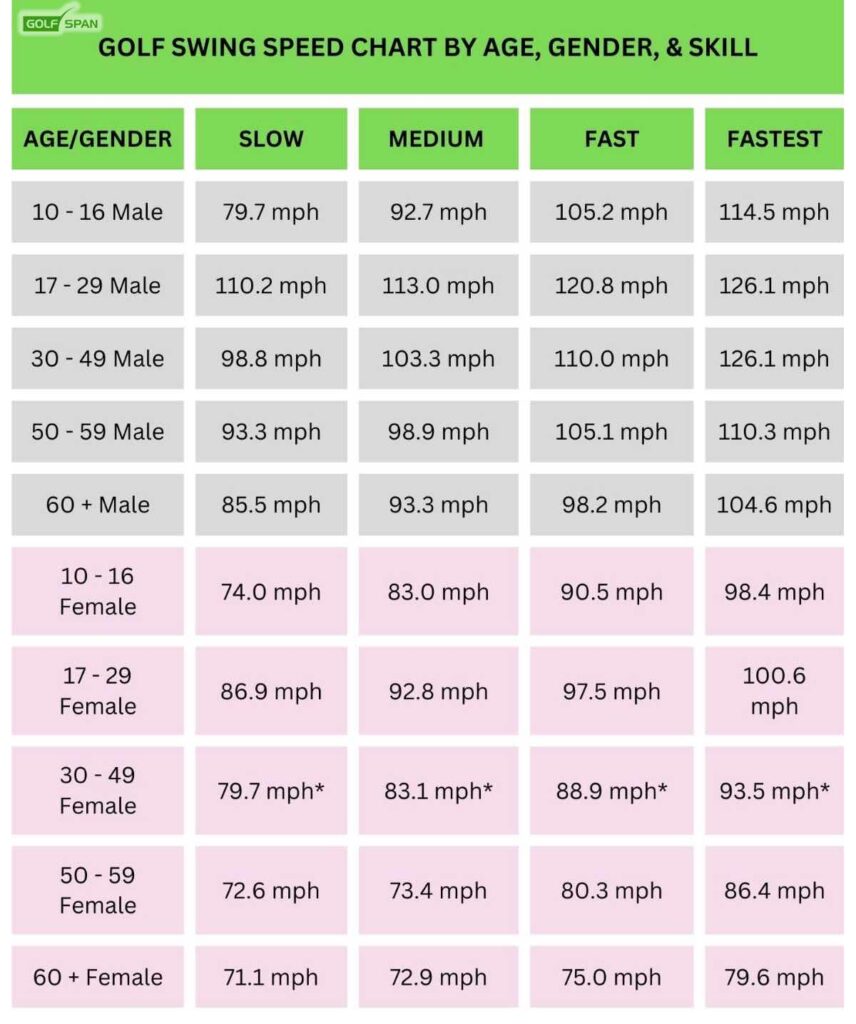
*Estimates due to a lack of participants in this age and gender group
** The data in the chart was compiled from a Titleist Performance Institute (TPI) study conducted in 2019.
Club head swing speed contributes to the distance a golfer can hit a golf ball. Countless factors contribute to how fast a golfer can swing, such as age, flexibility, strength, gender, and the efficiency of their swing mechanics.
The first factor I wanted to chart concerning swing speed is age and gender. The following chart represents the average swing speeds with a driver for several different age groups and by male and female golfers within them.
Age significantly affects how much clubhead speed a golfer can produce on average. Here is the main observation about swing speed versus age and gender:
- As you age, swing speed generally gets slower
However, as you can see from the chart, age does not necessarily have to slow you down completely. Some golfers in the 50 – 59 and 60+ age groups can still swing significantly fast. It all depends on how flexible someone can stay as they age.
Check this out: What Are the Golf Club Distances for Each Club? (Charts for All Skill Levels)
*Data from PGATour.com as of 7/9/23
**Data from PGATour.com as of 7/9/23
Average swing speeds by handicap data from TrackMan
Let’s look at average swing speeds by handicap level for male golfers.
A golfer’s playing ability and how efficiently they swings the club also directly impact how fast their swing speed is. When golfers understand how the swing is supposed to work and can execute those fundamentals correctly, the result is a much more efficient swing. That efficient swing will lead to an increase in swing speed.
Read on: What Driver Loft Should You Use? (Full Chart Based On Swing Speed)
Average PGA TOUR Club Head Speeds
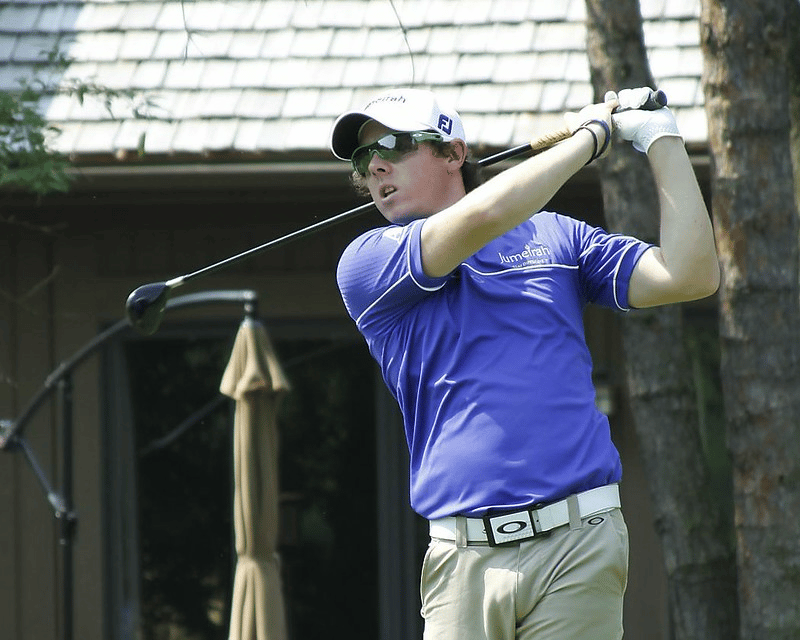
PGA TOUR professionals are among the best golfers in the world, so many golfers look to them as guides to playing the game correctly.
Note: Even though these speeds happened on a specific date in 2024, they’re still applicable today since swing speeds don’t rise significantly over time.
*Compiled through Rocket Mortgage Classic, 7/2/23
- Tour Pro Golfer Average Swing Speed – 115.24
- Tour Pro Golfer Average Driving Distance – 299.40
PGA TOUR Slowest 10 Driver Swing Speed Averages
*All data from PGATour.com
**Compiled through Rocket Mortgage Classic, 7/2/23
As you may have noticed, some of the PGA TOUR pros in the top 20 in swing speed with the driver are outside the top 20 in average driver distance. This is because of a stat called Smash Factor, which measures the efficiency of a swing.
Smash Factor is calculated by dividing the ball speed by the clubhead speed. Additionally, where the ball comes in contact with the clubface matters quite a bit as well.
Here are some examples of players with fast swing speeds who are outside the top 20 in driving distance.
Of those short knockers in the bottom 10 on the PGA TOUR this season in swing speed, and many of whom are very near the bottom in driving distance, all but two have a PGA TOUR victory on their resume.
*Data compiled from TrackMan’s 2017 PGA TOUR Data Points
I use data from TrackMan all the time with my students as a reference for what peak performance stats look like.
Above, I have pulled out the club head speed and carry distances for each club, on average, on the PGA TOUR.
TrackMan notes that these AVERAGE stats from 2017 have mostly stayed the same over the last six years. The top players on the PGA TOUR have gotten faster and carry the ball longer, but, on average, the chart above still holds close to today’s average.
Average LPGA TOUR Club Head Speeds
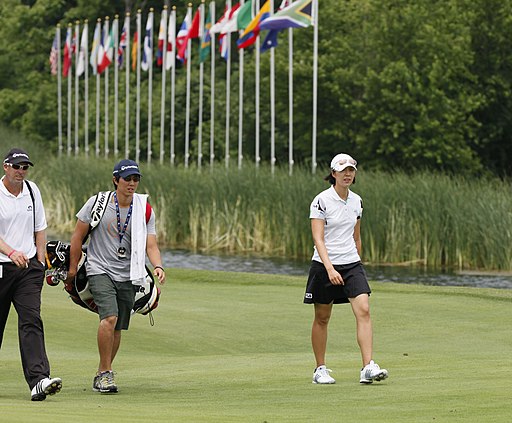
The LPGA does not keep data on swing speed. However, the average swing speed with the driver hovers around 95 mph, per TrackMan. As we noticed in the statistics above for the PGA TOUR, there is somewhat of a correlation between swing speed and driver distance, but not necessarily always.
The current top drivers on the LPGA Tour shake out as follows:
Driving Distance Averages from LPGATour.com
Swing Speed Estimates Via TrackMan
Data compiled through 7/9/23
As noted previously, TrackMan is a go-to source for swing and club data for many coaches and players. I use data from TrackMan with my students all the time. For my female students, as well as slower-swinging male students, one of my go-to charts is TrackMan’s 2017 LPGA TOUR Data Points .
Compiled data from TrackMan
As noted previously, TrackMan notes that these AVERAGE stats from 2017 have mostly stayed the same over the last six years. The top players on the LPGA TOUR have gotten faster and carry the ball longer, but, on average, the chart above still holds close to today’s average.
In 2012, Ryan Winther set the world record for swing speed at 167 mph, and that swing produced a ball speed of 225 mph.
Recent long-drive phenom, Kyle Berkshire, has come close to Winther’s record, recording a swing speed of 160. Berkshire does however have the highest ball speed ever recorded at 236.8 mph… Say What?!?
More from Golf Span: The 10 Best Drivers for Slow Swing Speed
Swing speed and distance have become one of the most talked about topics in the game over recent years. It seems that everyone in golf has a need for speed! There is no denying that swing speed is a hot topic in golf.
Golfers are always looking for tips and tricks to improve their swing speed. I will break down my tips for you in two different ways. The first is the more traditional ways we, as instructors and coaches, point students toward when working on improving their swing speed.
The second will come from my friend, Michael Romatowski, founder and creator of the revolutionary Mach 3 Golf Speed Training System. Mike’s system is really helping 1,000’s of golfers get faster with their swing.
Some of the more traditional tips for golfers to help them increase their swing speed include the following:
- Train Your Body to Get Faster- If you can increase your flexibility and mobility, reaching faster swing speeds will be more realistic. How a golfer moves their body, in terms of how much they can rotate their hips and upper torso, will play a big part in their production of swing speed. Getting yourself into the habit of stretching your body regularly will help your ability to swing faster.
- Equipment can make a difference- Having the right equipment for you can make a big difference in your ability to swing faster. Some of the critical things you need to consider in terms of equipment include:
- The overall weight of the club- The lighter the club, the faster you can swing it. That is straight-up science, folks.
- The type of shaft you use- The shaft matters in golf. From the length, to the flex, and where the kick-point is, all of these things equate to your ability to swing at your maximum speed.
- The head of the club- Golf equipment technology has made massive gains over the last two decades. The clubheads on today’s drivers can offer maximum forgiveness and create a “trampoline effect” with the ball coming off the face. Test different drivers, and you may be surprised at what gains you can make by simply having the right club.
I have recently become a massive fan of a speed training program called the Mack 3 Golf Speed Training System . It was developed by Michael Romatowski. Mike is a multi-certified personal trainer, golf fitness expert, and post-rehab exercise specialist. I have spent a lot of time talking with Mike recently; he was a recent guest on my Quite Please Golf Podcast. You can listen to that episode here.
Mach 3 is a year-round speed training protocol that has produced an average gain in clubhead speed for program participants of 11.5 miles per hour. The tools used in Mach 3 are dynamic and unique, allowing golfers to experience the sensation of “Speed Out in Front,” which is the hallmark of Mach 3.
Some of the critical points of Mach 3 that I like include:
- It’s Open To All – The Mach 3 program is for golfers of all ages, genders, and playing abilities.
- It’s Fun & Safe – Workouts are fun, non-exhausting, safe, and athletic in nature.
- It’s Accessible to All – Speed training workouts can be held indoors or outdoors.
- It’s Optimized – Train for golf without “bulking up” and using natural golf body motions.
The overarching theme of Mach 3 is the “Speed out in front” concept. “Speed out in front” means that a golfer needs to become much more target-oriented when swinging. Anything after impact and up to the end of your swing is “out in front.”
Because the golf swing is such a fast movement, taking roughly only 1.25 seconds, it is essential to think in your mind to be a few steps ahead. Golfers often think of the ball and impact with the ball as the finish line when, in reality, it is only the mid-way point. If you focus on the ball as the ultimate goal, you will move slower into it at impact.
Mach 3 trains golfers to think of the finish line of the swing as being the top of your finish. You become hyper-focused on the target, the finish of the swing, and getting all of your energy, momentum, and speed “out in front” and past the point where the ball is at impact…well past it.
Mach 3 will help any and all golfers that give this concept a try. As mentioned earlier, program participants’ average gain in clubhead speed is around 11.5 miles per hour. That is significant!
If you’re a golfer seeking to improve your game, understanding the insights a golf swing speed chart can provide is invaluable. These charts break down swing speeds by various factors such as age, gender, and skill level, offering a wealth of data that helps golfers understand where they stand. My extensive experience as a golf coach has shown me that these statistics are crucial for those aiming to improve their performance. Surprisingly, many golfers discover they don’t swing as fast or hit as far as they initially thought.
The charts reveal that factors like age, gender, and skill level profoundly impact your swing speed and, subsequently, your driving distance. However, it’s important to note that age doesn’t necessarily have to slow you down. Many golfers in the 50 – 59 and 60+ age brackets can still generate impressive swing speeds, particularly if they maintain good flexibility and employ proper swing mechanics.
To boost your swing speed, you can rely on tried-and-true methods and cutting-edge techniques. On the traditional side, improving your body’s flexibility and selecting the right equipment can make a significant difference. For instance, lighter clubs and the right shaft type can notably increase your swing speed. On the innovative front, training systems like the Mach 3 Golf Speed Training System have helped thousands of golfers achieve faster swings by focusing on functional training tailored to golf performance.
To wrap up, a golf swing speed chart is an essential tool for anyone serious about upgrading their golf game. Combining this data with top tips for improving your swing speed can set you on the path to becoming a more formidable golfer. Whether you’re a beginner or looking to fine-tune your skills, a strategic approach backed by sound data can help you reach new heights in your golf career. Stay tuned for the latest updates and trends in golf statistics and training techniques.
More from me on Golf Span: How to Increase Swing Speed: 10 Tips

Brendon Elliott
Brendon is Class A PGA Professional and founded Little Linksters, LLC, and its nonprofit arm, the Little Linksters Association for Junior Golf Development. He won 25+ prestigious industry honors, including the 2017 PGA National Youth Player Development Award. He graduated from the PGA of America Management Program and has a handicap index of 7.8.
He has played golf for over 40 years and currently plays twice a month at the Eagle Dunes Golf Club near Sorrento, Florida. He loves Srixon clubs and plays a ZX5 driver with Z 585 irons. He's written over 60 articles on GolfSpan and specializes in sharing tips to improve your golf game. You can connect with Brendon at LinkedIn , X , IG , FB , his website , or [email protected] .
- Brendon Elliott https://www.golfspan.com/author/brendon-elliott The Birdie Mat Pro: Pros, Cons, and Verdict
- Brendon Elliott https://www.golfspan.com/author/brendon-elliott GolfKicks Review: Pros, Cons, Verdict
- Brendon Elliott https://www.golfspan.com/author/brendon-elliott USGA's Ball Rollback: Will It Save Golf or Spark Backlash?
- Brendon Elliott https://www.golfspan.com/author/brendon-elliott 10 Longest Drives in PGA Tour History
You might also like these

CONNECT WITH US


Average PGA Tour Ball Speed: Blazing Drives
- Frank Coffman
- October 2, 2023
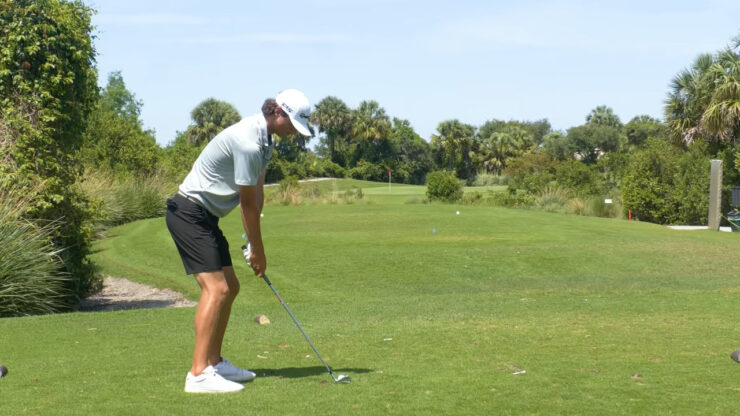
I still remember the first time I ever swung a golf club; the anticipation, the nervous grip, and the ultimately comedic stagger as the club hit the ground rather than the ball. Over the years, my swing has improved and with it, the speed at which the ball flies off the tee.
This transformation sparked my interest in this subject, especially within the professional golfing arena. The numbers we see today in the PGA Tour are not just about the athletes’ raw power or advanced equipment; they are about the evolution of the sport, the intricate dance of various factors harmonizing to produce the perfect shot.
Now, join me as we explore the realm of golf ball velocity in professional tournaments, unraveling the myriad aspects that contribute to the awe-inspiring figures witnessed on the PGA Tour.
Velocity in Professional Tournaments
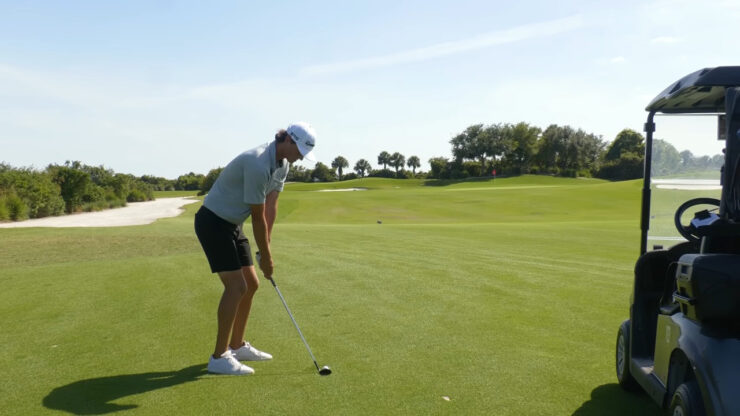
In the vast landscape of professional golf, grasping the average golf ball velocity is crucial. This element serves as a mirror reflecting the advancements in both athlete’s skills and equipment technology. Within the professional circuit, the golf ball typically takes off at around 170 mph.
This impressive figure is not just a result of the athlete’s physical capability, but also a testament to the seamless blend of optimal technique and cutting-edge equipment, all working in concert to produce such powerful results.
Evolution Over the Years
Through the annals of golf history , the average in professional tournaments has seen substantial transformation. This shift has been driven by continuous technological advancements, changing the face of the game profoundly.
From the era of wooden clubs and feathery balls to the contemporary age of sophisticated equipment crafted from advanced materials, the journey has been monumental.
Today’s equipment enables significantly higher velocities, contributing to enhanced game performance and more exciting tournaments, underlining the importance of continuous innovation in this sport.
What Factors Influence it?
Many different elements collectively influence the golf ball’s velocity in professional tournaments, providing a multifaceted view of the subject. A foremost aspect is the swing velocity. Generally, a quicker swing translates to a higher golf ball velocity.
However, it’s not just about raw power.
The angle and quality of contact between the club and the ball play crucial roles, highlighting the intricate balance required to optimize the velocity.
The Swing’s Role
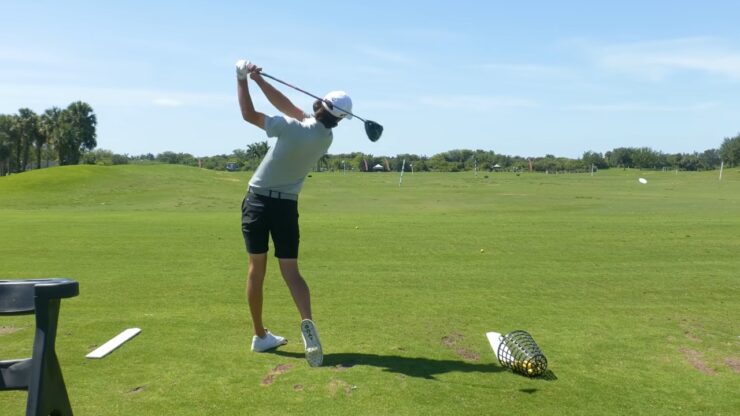
The velocity at which a golfer swings the club plays a pivotal role in determining the resulting velocity. Understanding this relationship is paramount for enhancing performance in professional tournaments. A swift club swing, typically around 110-115 mph, can generate a velocity of approximately 165-170 mph in professional circuits.
It’s not merely about power, though. Achieving optimal velocity also demands precise contact, maintaining the right angle and position throughout the swing, reaffirming the complex nature of the sport.
Impact of Equipment
The role of equipment in determining golf ball velocity in professional tournaments cannot be overstated. It’s a significant aspect that shapes the game, ensuring athletes can achieve their best performance. In today’s world, equipment is a marvel of technology and design.
Modern clubs, especially drivers, are meticulously crafted with materials that optimize both strength and weight. These advancements contribute substantially to enhancing ball velocity, allowing golfers to achieve more powerful shots.
Design Innovations
In the arena of professional sport, innovations in club and ball design have made a resounding impact, pushing the boundaries of what athletes can achieve. Modern drivers are often made with state-of-the-art materials like titanium and carbon composite, enhancing strength while minimizing weight.
It allows for faster swings, consequently leading to increased velocity. Additionally, advancements in design, including multi-layer constructions and innovative materials, contribute to optimal launch conditions, further maximizing velocity and distance.
Mastering the Technique
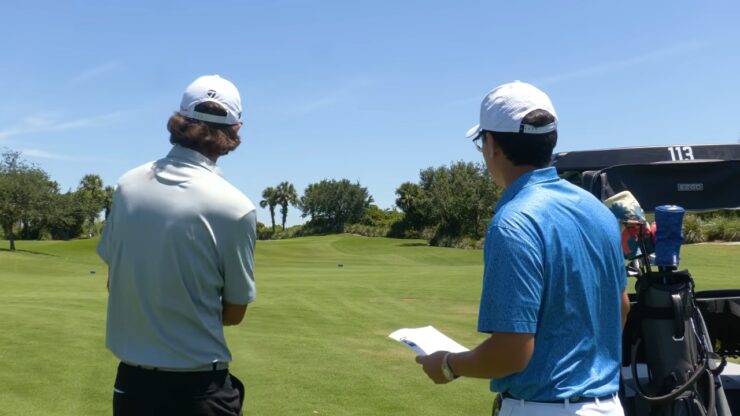
Behind the impressive velocities in professional tournaments lies the mastery of technique. It’s an essential element, underscoring the skill and expertise of professionals. A harmonious blend of power, precision, and timing is necessary to achieve optimal velocity.
Mastering the swing’s mechanics, the nuances of club and ball interaction, and refining the approach based on individual strengths and weaknesses all contribute to enhancing velocity in professional tournaments.
Perfecting the Swing
In the pursuit of optimal ball velocity, perfecting the swing is of paramount importance. It’s a journey of continuous learning and refinement, emphasizing the depth of skill required in professional sport.
Beyond physical strength, achieving a powerful and effective swing necessitates a deep understanding of biomechanics and rhythm. It’s about synchronizing body movements, maintaining balance , and ensuring optimal contact and follow-through.
These elements collectively influence the golf ball’s velocity, showcasing the intricate interplay of factors that define success in professional golf tournaments.
Physical Conditioning

Physical conditioning stands as a cornerstone for achieving noteworthy golf ball velocity in professional tournaments. Physical condition directly impacts their performance, including the velocity they can impart to the ball.
Athletic prowess is not solely about muscle strength. Endurance, flexibility, and core stability are crucial components that underpin an athlete’s ability to generate powerful and effective swings, underscoring their importance.
Physical Attributes
To maximize this segment, enhancing specific physical attributes is imperative. A comprehensive and well-rounded fitness regimen can contribute significantly to improving a golfer’s performance in professional tournaments.
- Strength Training : Builds the necessary muscle power for a faster swing.
- Flexibility Exercises : Ensures a full range of motion for an optimized swing path.
- Core Stability Workouts : Provides the foundation for a balanced and powerful swing.
- Endurance Training : Helps maintain consistent performance throughout the tournament.
Technology’s Contribution to Enhanced Velocity
Technology plays a pivotal role in the world of professional golf, notably influencing the velocity at which the golf ball travels. Advanced equipment, built with the aid of cutting-edge technology, enables golfers to achieve higher velocities with their shots.
Technological innovations have led to the development of equipment designed to optimize performance, allowing athletes to consistently hit powerful and accurate shots in professional tournaments.
Equipment and Performance Analytics
Embracing technology extends beyond just utilizing advanced equipment. Performance analytics, powered by modern technology, provides detailed insights into every aspect of a golfer’s game, including the velocity of their golf ball. Utilizing sophisticated sensors and analytics tools, golfers can obtain a granular view of their performance.
This information allows them to make informed adjustments to their technique, equipment, and strategy, fine-tuning every aspect to enhance their velocity and overall performance in professional tournaments.
What Does the Future Hold?

As we gaze into the future of professional golf, the aspect of golf ball velocity stands out as a crucial facet that will continue to evolve, reflecting advancements in technology, equipment, and athletic training. The continuous pursuit of excellence in professional sport will drive further innovations in all these areas.
These advancements will contribute to even higher velocities, pushing the boundaries of what professionals can achieve and making the sport more thrilling for both athletes and spectators. In the horizon, we can see numerous upcoming innovations and trends that promise to revolutionize the game, contributing to the overall performance.
Advanced materials, innovative design approaches, and state-of-the-art performance analytics technologies will continue to evolve. These advancements will offer golfers new opportunities to optimize their performance.
How can someone qualify for the PGA Tour?
To qualify for the PGA Tour, golfers must earn a “Tour card,” which can be obtained by finishing in the top 125 of the FedExCup standings or by excelling in the Korn Ferry Tour Finals. Golfers can also qualify by receiving sponsor exemptions or through Monday qualifying events.
What is the difference between the PGA and the PGA Tour?
The term “PGA” typically refers to the Professional Golfers’ Association, a global organization of golf professionals. The PGA Tour, on the other hand, specifically refers to the organization that conducts a series of golf tournaments in the United States and around the world.
How can a golfer increase their ball speed?
Improving ball speed may involve various approaches, including enhancing swing mechanics, increasing physical fitness, and utilizing higher-quality equipment optimized for performance.

Are there limits to ball speed in PGA Tour events?
There are no explicit limits to ball speed, but equipment used in PGA Tour events must adhere to specific regulations, which can indirectly influence ball speed. The emphasis is on maintaining a balance between technological advancement and the preservation of skill in the game.
What is the average ball speed from the previous season?
In the PGA TOUR for the 2022-2024 season, the average ball speed off the tee stands at 172.95 mph. However, leading the pack with the highest average ball speed is Cameron Champ, registering an impressive 190.74 mph.
Through the domain of golf ball velocity in professional tournaments, we’ve unraveled the tapestry of factors and elements that harmoniously blend to influence the speed at which the ball soars off the tee.
From the technological innovations in equipment to the physical prowess and perfected techniques of the athletes, each component plays a crucial role in shaping the ball speed dynamics in the world of professional golf.
As I stand on the tee today, the memory of my first clumsy swing brings a smile to my face. The knowledge of the multifaceted world behind each swing, the understanding of the intricate interplay of factors influencing ball speed, enhances the appreciation and passion for the beautiful game of golf.
Related Posts:
- Top Performers of the PGA Tour So Far: Swinging for…
- 2022's PGA Tour Schedule Explained
- Average Swing Speed for Each Skill Level of Golfer:…
- Masters to PGA: Predicting the 2024 Major Tournament…
- Take Your Own Tour - The 5 Best Golf Courses In The USA
- 12 Best Golf Balls for Average Golfers 2024 -…
- Ball Speed , Golf Stats , Golf Techniques , PGA Tour , Power Drives
Related Posts

What Happened to 3Balls? Navigating the Changes in Golf Equipment Retail

How Golf Has Become One of the Most Popular Betting Sports?

The Fascinating History of Golf Polo Shirts: Weaving the Thread of Time

What to Do if You Get Sued for a Golf Cart Accident: 7 Legal Tips

Golf Course Maintenance: Tips for Club Cars and Utility Vehicles

How to Obtain Golf Fitness Instructor Certification: 8 Things You Need to Know

How to Improve Your Chipping and Pitching – Take Your Game to the Next Level
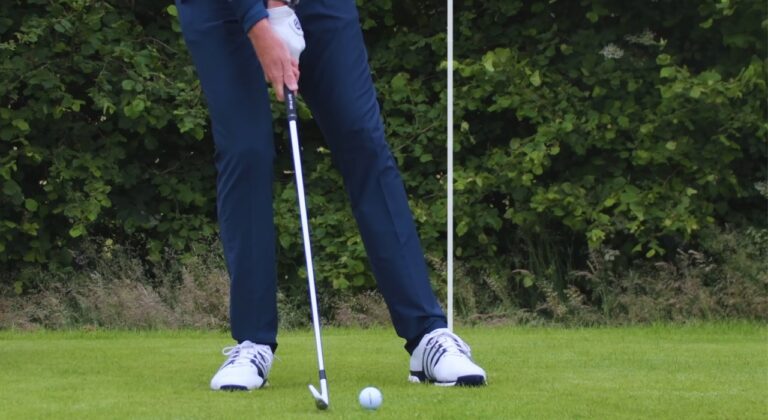
Golf Etiquette: Unwritten Rules on the Course

Affiliate Disclosure
Floridaelitegolftour.com is a participant in the Amazon Services LLC Associates Program, an affiliate advertising program designed to provide a means for sites to earn advertising fees by advertising and linking to Amazon.com. Amazon, the Amazon logo, AmazonSupply, and the AmazonSupply logo are trademarks of Amazon.com, Inc. or its affiliates.
[email protected]
- Privacy Policy
- Terms and Conditions
© 2024 floridaelitegolftour.com
- Get All Access Membership
- All Access Login
Top Speed Golf
The Only 5 Golf Swing Pieces That Really Matter

Golf Science Vault
Gs005. ball speed | understanding the science of golf (golf pro training).

Why You Need This: In this video, you'll learn everything you need to know about ball speed.
Ball speed is one of the biggest determinants of how far you hit the ball.
Now, you know that off-center hits will likely hurt your ball speed and distance...
But what you may not know is exactly how much your ball speed varies at different areas of contact on the clubface.
In fact, there's even an area that's slightly off-center that can actually help get you more ball speed.
In today's video, you'll get an interesting, in-depth analysis of ball speed.
You'll discover...
- What factors primary determine your ball speed, and
- How PGA Tour players produce ball speed, including their stats for club speed, smash factor, and more.
Watch now to learn the science of ball speed!
Golf Pros Featured:
Instructors Featured: Clay Ballard
Video Duration: 7:48
Watch This Video Now!
Normally, this video in our step-by-step, course-based training is only available to our All Access Members...
But I'll let you watch this ONE video today only... because I can already tell I'm going to like you !

Find What You Need
- Get Free Membership
- Become All Access Member
- Help & Support
- Online Golf Instruction
Is This for You?
While anyone but accomplished Tour players could benefit from my instruction...
...Our typical member desires to get down to a near scratch handicap...
...Is tired of all the "quick fix" junk in the market...
...And also doesn't want to be overwhelmed with every detail on the planet.
Membership Signup: [email protected] 1-888-730-7557 ext. 1 Support and Feedback: [email protected] Submit Ticket
Become a hero by telling your friends about our instruction!
Just think of how much fun it will be having them as part of the community. Click for Sharing Options!
Finish Watching Your Video Now!

And get more free videos emailed to you!
Clicking the button above means I protect your email, and you accept my Terms of Use .
Advertisement
2024 titleist golf balls: which is right for your game and budget, share this article.
For more than two decades, the Titleist Pro V1 and Pro V1x have been the most-played golf balls on the PGA Tour, the DP World Tour, the LPGA Tour and at every major amateur event, including the NCAA Championships, but the Titleist portfolio of golf balls goes much deeper than those two offerings. According to Titleist, in 2023, the company’s golf balls were used to win 159 professional events, while the next closest competitor scored 28.
Titleist golf balls are typically updated on two-year product cycles, so after the 2023 release of new versions of the Pro V1 and Pro V1x, it was not surprising that the brand did not release another update before the start of the 2024 season. However, Titleist did drop a new AVX, Tour Soft and TruFeel.
The Titleist Tour Speed, which had been a complimentary ball to the Tour Soft, has been discontinued to streamline the family of offerings.
For 2024, there are seven golf balls available at retail , with the Pro V1, Pro V1x and Pro V1x Left Dash elevated to the most-premium position in the lineup. Titleist feels that if price is not taken into consideration, those three golf balls offer the best overall performance and one of them would be ideal for nearly all golfers. However, price, as we all know, is a factor for most golfers when it comes to buying golf balls, so the other four balls — AVX, Tour Soft, Velocity and TruFeel — are designed with specific player types in mind and at lower prices.
The best way to find out which Titleist golf ball is best suited for your game is to try them, starting around the green with chip shots, pitch shots and short approach shots before progressing into iron shots and finally tee shots. Consider how much spin you generate and the control you have with your wedges, the flight of your iron shots produce and then the distance you create with your fairway woods and driver. Prioritize what you need your golf ball to do, then take price into consideration, and you should be able to find a solid choice for your game and your wallet.
Shop all Titleist golf balls at PGA TOUR Superstore Shop all Titleist golf balls at Worldwide Golf
Titleist Pro V1

The 2023 Titleist Pro V1. (David Dusek/Golfweek)
Price: $54.99 per dozen
Specs: Three-piece construction with cast urethane cover Since 2000, the Pro V1 has been one of the most popular and most-played balls in golf, so we will use this ball as the baseline for comparisons in this article. The Pro V1 is a three-piece ball that features a high-gradient core designed to be soft in the center and grow progressively firmer toward the perimeter. That core is encased in a firm mantle layer, which in turn has a very thin and soft cast urethane cover applied over it. The large differential between the rigid outer portion of the core and the soft inner area helps to reduce spin with your long clubs, while the soft cover on top of the mantle makes it easier for your short irons and wedges to grab the ball on approach shots, chips and pitch shots to generate spin and control.
Shop Titleist Pro V1 golf ball at PGATSS Shop Titleist Pro V1 golf ball at WWG
Titleist Pro V1x

The 2023 Titleist Pro V1x. (David Dusek/Golfweek)
Specs: Four-piece, dual-core construction with cast urethane cover Like the standard Pro V1, the Pro V1x was most-recently updated for 2023. It remains a four-piece ball made with a dual-core design inside a firm mantle layer that is encased in a soft urethane cover. In a higher-compression ball like as the Pro V1x, excessive spin can be generated with longer clubs, but by using two cores, Titleist designers were able to drop the spin generated at higher speeds. For the current ball , the inner core’s volume was increased 44 percent, and like the Pro V1’s core, it is softer in the center and gets progressively firmer toward the perimeter. The outer core, which is slightly thinner, was made marginally firmer. T he new gradient core amplifies the effect of having two cores with different levels of firmness, so the 2023 Pro V1x can now deliver more speed. In addition to feeling firmer than the Pro V1, the Pro V1x should fly slightly higher and generate slightly more spin, both off the tee and around the green.
Shop Titleist Pro V1x golf ball at PGATSS Shop Titleist Pro V1x golf ball at WWG
Titleist Pro V1x Left Dash

The Pro V1x Left Dash. (David Dusek)
Price: $54.99 per dozen
Specs : Four-piece, urethane-covered balls available in white The Titleist Pro V1x Left Dash made its debut in 2019 and has not been updated, mainly because it services a very specific group of golfers. Like the standard Pro V1x, it is a four-piece ball with a dual-core system inside a mantle layer and a urethane cover. The dual-core system helped Titleist engineers create a greater firmness separation between the inner core and the outer core, which for fast-swinging players can mean more distance off the tee with less spin. The Pro V1x Left Dash will be the firmest-feeling ball in the lineup, but what makes it unique is it should produce less spin on full-swing shots than either the Pro V1 or Pro V1x. At the same time, Pro V1x Left Dash will fly higher than Pro V1, making it an interesting alternative to the Pro V1 and Pro V1x for fast-swinging golfers who often produce excessive spin that robs them of distance.
Shop Titleist Pro V1x Left Dash golf ball at PGATSS Shop Titleist Pro V1x Left Dash golf ball at WWG
Titleist AVX

The Titleist AVX ball for 2024. (David Dusek/Golfweek)
Price: $49.99 per dozen
Specs: Three-piece, urethane-covered golf balls. Available in White and Yellow. The first AVX was released in 2017 as an alternative to the V and X balls ( get it, AVX ) and this ball was updated for 2024. Like its predecessors, the current AVX is a three-piece ball with a urethane cover, but now the core is gradational, like the Pro V1, and the 2024 edition has been given a softer, thicker urethane cover to enhanced greenside spin. The softer, thicker urethane cover also helps to make the AVX feel softer at impact, even though the updated ball’s overall compression (80) is the same as the 2024 version. Compared to the Pro V1, the AVX is feel softer, produce less full-swing spin and fly lower on full-swing shots, but it’s greenside spin nearly matches Pro V1. In Titleist testing with a full-swing wedge, the updated AVX generated an average of 9,398 rpm of spin, which is only 201 rpm less than the current Pro V1. The AVX now has a suggested retail price that is $5 less than Pro V1, Pro V1x and Pro V1x Left Dash.
Shop Titleist AVX golf ball at PGATSS Shop Titleist AVX golf ball at WWG
Titleist Tour Soft

Titleist Tour Soft for 2024. (David Dusek/Golfweek)
Price: $39.99 per dozen
Specs: Two-piece, ionomer-covered golf balls. Available in white, yellow and green. Updated for 2024, the Tour Soft is a two-piece ball that has a massive gradational core to help golfers generate more speed and distance. The cover of the Tour Soft has a 346-dimple pattern that Titleist designers created to help the ball hold its line more effectively in windy conditions. However, unlike the Pro V1, Pro V1x, Pro V1x Left Dash and AVX, the Tour Soft does not have a urethane cover. Instead, the cover is made using an ultra-thin ionomer that Titleist refers to as Fusablend. Titleist claims that it differs from the hard ionomers put are used in most distance balls sold at budget prices. Titleist adds other materials to the ionomer to soften it, so the cover can be easily grabbed by the grooves in your wedges and short-irons on approach shots. Does it provide the same level of greenside spin that the urethane-covered Pro V1 and Pro V1x balls? No, but the Tour Soft is $15 less expensive than the Pro V1, Pro V1x, Pro V1x Left Dash and $10 less than AVX, and Titleist claims that it performs better than harder ionomer covers on the market.
Shop Titleist Tour Soft golf ball at PGATSS Shop Titleist Tour Soft golf ball at WWG
Titleist Velocity

Titleist Velocity for 2022. (David Dusek/Golfweek)
Price: $29.99 per dozen
Specs: Two-piece, Surlyn-covered ball The current Velocity was released in 2022 and like its predecessors, it is a two-piece ball that features a large core and an ionomer cover. However, the current Velocity’s higher-compression LSX core measures 1.55 inches in diameter. A golf ball’s total diameter is 1.68 inches, so this core is massive, helping it deliver more speed off the tee and with long irons. With a price that is $25 per dozen less than Titleist’s most-premium offerings, and with a name like Velocity, golfers know what this ball is about. Unlike Titleist’s urethane balls that use the cover material to help generate spin and stopping power on the green, Velocity crea tes stopping power with trajectory. Velocoty flies higher than most Titleist balls, so it can create a steeper descent angle that can help iron shots and wedges naturally stop quicker.
Shop Titleist Velocity golf ball at PGATSS Shop Titleist Velocity golf ball at WWG
Titleist TruFeel

Titleist TruFeel for 2024. (David Dusek/Golfweek)
Price: $24.99 per dozen
Specs: Two-piece, ionomer-covered golf balls. Available in white, yellow and matte red The latest version of TruFeel has a newly-formulated core that Titleist calls TruTouch. While it is slightly smaller than the core in the previous TruFeel ball, it still helps golfers generate more ball speed for good distance off the tee. The benefit of going with a smaller core is it allowed Titleist to make the TruFlex cover, which is made from a blend of ionomer and softening polymers, slightly thicker. The softer cover can be grabbed by the grooves of wedges and short irons more easily, so the 2024 TruFeel should give players more greenside spin and control. TruFeel has a lower compression to go along with the thicker cover, so at impact, the ball will feel softer than other Titleist balls, but the dimple pattern and cover design were made to help it create a low, penetrating ball flight. Think of the Titleist TruFeel as the best Titleist ball the company can make, knowing that the price needs to be less than half of what golfers pay for a Pro V1.
Shop Titleist TruFeel golf ball at PGATSS Shop Titleist TruFeel golf ball at WWG
See more equipment: Best drivers for 2024 | Best irons for 2024 | Best putters for 2024 | Best golf balls for 2024
We occasionally recommend interesting products and services. If you make a purchase by clicking one of the links, we may earn an affiliate fee. Golfweek operates independently, though, and this doesn’t influence our coverage.
Most Popular
Social media reacts to protestors storming the green at the 2024 travelers championship, meet the 60 players who qualified for the 2024 summer olympic women's golf competition in paris, the 2024 presidents cup is three months away. these 15 americans lead in the team standings, golfweek's best 2024: top public-access golf courses in every state, ranked, rocket mortgage classic 2024 odds, course history and picks to win, meet the 60 players who qualified for the 2024 summer olympic men's golf competition in paris, these 15 internationals lead the team standings for the 2024 presidents cup at royal montreal.
Travelers Championship
Watch on espn+, clark featured group, featured hole #15, aberg featured group, featured hole #16, featured holes 5, 11, 15 & 16, bradley & fowler groups, homa & matsuyama groups, main feed + spieth group, finau featured group, thomas featured group, latest golf videos, scottie scheffler recounts feelings during travelers protest.
- Terms of Use
- Privacy Policy
- Your US State Privacy Rights
- Children's Online Privacy Policy
- Interest-Based Ads
- About Nielsen Measurement
- Do Not Sell or Share My Personal Information
- Disney Ad Sales Site
- Work for ESPN
- Corrections
- Summer Racing ExternalLink
- Champions League
- Motor Sports
- High School
- Shop ExternalLink
- PBR ExternalLink
- 3ICE ExternalLink
- Stubhub ExternalLink
- Play Golf ExternalLink
2024 Travelers Championship scores, leaderboard: Scottie Scheffler trails Tom Kim by one after Round 3
Kim is 18 under heading into sunday's final round of the travelers championship.
For the second consecutive day, the 2024 Travelers Championship experienced a long suspension of play as players were pulled off the golf course due to severe weather at 3:30 p.m. ET only to return 2 hours and 50 minutes later. Leading as he stepped off the golf course for the delay, Tom Kim kept his wits about himself Saturday and stepped off the 18th green with the lead for the third straight day.
Carding a 5-under 65 in Round 3, the 22-year-old sits at 18 under and one clear of Scottie Scheffler and Akshay Bhatia heading into Sunday's deciding round. A win at TPC River Highlands would represent the fourth — and most certainly the biggest — of Kim's young career, but it will have to be earned with the number of stars that lurk.
After experiencing a somewhat sloppy restart with a couple of bogeys on the initial portion of his inward half, Scheffler surged late with five birdies in his last six holes to push his name back into contention at 17 under. Sharing a birthday, practice rounds and time off the golf course with Kim, the two will now share a final round tee time together as they wrestle for the last signature event title of the season.
Scheffler drafted off the momentum of his playing partner, Bhatia, who kept pace and will round out that final threesome on Sunday thanks to back-to-back birdies on Nos. 17-18. Meanwhile, Sungjae Im seeks his first win on the PGA Tour in over two years from two adrift at 16 under is alongside the 2022 champion Xander Schauffele at that number thanks to a closing 40-foot birdie effort.
In total, there are 10 players within five strokes of Kim's lead after 54 holes with heavy hitters like Collin Morikawa, Justin Thomas, Tony Finau, Shane Lowry, Patrick Cantlay and Mr. 59 himself, Cameron Young, all jostling for one of the biggest trophies on the PGA Tour playing calendar.
1. Tom Kim (-18)
It took him 40 holes, but Kim dropped his first (and only) shot of this tournament when he 3 putted from 11 feet on the par-4 4th. Things could have started to move quickly for the young gun as names like Scheffler, Schauffele and Morikawa made their moves and pushed Kim out of the lead for the first time since Thursday. He hung tough, however, and played his last 14 holes in 6 under to secure a one-stroke lead with one round to play.
"I'm going to go out tomorrow with the same game plan and try to do the things that I've been doing and if it's good enough, it's great, but if someone's better than that, I can't do anything about it. So just kind of go in with the expectation of there's just, it's a stacked leaderboard, out here a 5-, 6-shot lead is not safe at all. So I got to go out tomorrow and do the same game plan and execute."
Other contenders
T2. Scottie Scheffler, Akshay Bhatia (-17) T4. Xander Schauffele, Sungjae Im (-16) 6. Collin Morikawa (-15) T7. Tony Finau, Shane Lowry, Justin Thomas (-14) T10. Cameron Young, Patrick Cantlay (-13)
For a part of the back nine, Scheffler looked a little out of sorts as he dropped a shot on a short par 3 and missed a tee shot wide leading to another. As far as three off the lead at one stage, the five-time winner this season put on his hard hat and got to work. Five birdies over the course of his final six holes including a laser into the tricky par-4 17th and another to tap-in distance on his finisher positioned the Texan beautifully for another sprint to the winner's circle.
"Sometimes when you're in pairs you can feed off each other the wrong or the right way," Scheffler said. "Today, especially at the end, we were feeding off each other what I would say in the right way. It's always a good thing."
Cameron Young cards the round of the season
The former PGA Tour Rookie of the Year became the 13th player in PGA Tour history to card a sub-60 round Saturday at TPC River Highlands. After playing his first four holes in a 5-under fashion, Cameron Young added a couple birdies on his front nine to turn in 28. A birdie on No. 13 was followed by his second eagle of the round on the short par-4 15th. One last circle was put on his scorecard on the par-4 17th meaning a par on the last was good enough for Young's 59. Coming into the week, Young had carded nine straight rounds at par-or-worse and coming into today, he didn't feel particularly great about his chances either. That's just golf.
"Woke up, would have preferred to go back to sleep," Young said. "Did exactly what I do every day coming to the golf course, get a coffee, ate, saw the physio, and went out there, warmed up. Didn't feel particularly awesome. I chunked a few less on the range than I did yesterday. Then, yeah, came out and just was very comfortable and things just started coming down close to the hole."
2024 Travelers Championship updated odds and picks
- Scottie Scheffler: 3/2
- Tom Kim: 7/2
- Xander Schauffele: 5-1
- Akshay Bhatia: 7-1
- Sungjae Im: 12-1
- Collin Morikawa: 12-1
Kim has been the best player this week in all the right areas. He's holing putts with consistency, splitting fairways, and striking his approach shots close. He shouldn't be phased by the pairing with Scheffler as the two are good friends and he has plenty of horsepower to get to a winning score that may touch 25 under.
Patrick McDonald recaps moving day at the 2024 Travelers Championship. Follow & listen to The First Cut on Apple Podcasts and Spotify .
Scheffler surging
That's now three birdies in his last four holes and Scottie Scheffler is just two back. It's been an odd back nine so far with a couple of sloppy bogeys, but the world No. 1 is hanging tough and gets to 15 under thanks to his latest 2 on the par-3 16th.
Schauffele surging
That's now two birdies in a row for the 2022 champion and he has tied for the lead at 16 under. Xander Schauffele hasn't had the best week from tee-to-green so far, but he is making putts with confidence. He'll try to keep this train rolling into the clubhouse with four holes left.
Kim's lead returns to two
With a bogey from Akshay Bhatia on No. 12 and another birdie on another par 3 on No. 11 from Tom Kim, the South Korean's margin is now two at 16 under. After seeing his name drop off the pace early, Kim has handled himself beautifully with four birdies in his last seven holes.
Final two make the turn
They're going to have to play a little faster on this second nine, but the final pair have made the turn with Tom Kim alone out in front at 15 under. A birdie conversion from just inside 9 feet out of the restart on the par-3 8th pushed Kim's name out in front of Scheffler, Schauffele, Bhatia and Collin Morikawa who just added a birdie on the par-4 9th.
Let's play ball!
Alrighty, the official delay is 2 hours and 50 minutes as players return to the golf course. Let's set the scene as Tom Kim and Akshay Bhatia lead the way at 14 under. That final pair of Kim and Collin Morikawa are currently through six holes and according to officials they only have 2 hours and 20 minutes to play.
Play scheduled to resume at 6:20 p.m. ET
The rain has stopped falling and the grounds crew is on the golf course trying to make it playable for the rest of the day. After a nearly three-hour delay, play should begin back up again at 6:20 p.m. which should give the final group enough time to finish their third rounds.
More golf to come
Sunset is around 8:30 p.m. ET and there is a chance that we get these guys back onto the golf course around 6 p.m. With the final group with 12 holes to play, this should mean that we should finish the third round today. More to come.
CBS Sports HQ Newsletter
We bring sports news that matters to your inbox, to help you stay informed and get a winning edge., thanks for signing up, keep an eye on your inbox., there was an error processing your subscription..

Rocket Mortgage Classic preview, expert picks

Is Scottie in 2024 actually rivaling Tiger in 2000?

Protestors with smoke bombs tackled at Travelers
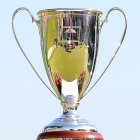
Travelers purse: Scheffler up to $28M in winnings

Cameron Young shoots 59 in Round 3 at the Travelers

Tiger receives exemption into signature events

Charlie Woods qualifies for first U.S. Junior Amateur

Davis Love III enthused about golf's young stars

Johnny Damon: How I started loving golf

Jim Furyk offers key advice to Ryder Cup captains
Power Rankings: Rocket Mortgage Classic
Power Rankings
Change Text Size
The conclusion of the Travelers Championship signified not only the end of the Signature Events but also a cadence of those weaved into two majors and other formats across the last two months. While all of it was consequential and historic, the most impactful segment of the season for many is about to begin.
Starting with this week’s Rocket Mortgage Classic, PGA TOUR membership is promised six opportunities of Full-Field competition in seven weeks. The stretch will include consecutive weeks with Additional Events in July and a week off for the Olympics. Then, once the winner of the Wyndham Championship is crowned on Aug. 11, the field of 70 will be set for the FedExCup Playoffs.
Detroit Golf Club hosts for the sixth time. For details on the scorer’s paradise and other intel concerning the tournament, continue reading beneath the ranking of those projected to contend.
No excuses. Professional athletes aren’t prone to them, anyway, but if any in the field of 156 at Detroit Golf Club can’t find his game there, he won’t find it anywhere.
For one, the stock par 72 remains unchanged. It tips at 7,370 yards and surrendered a scoring average of 69.919 a year ago. That’s officially the lowest of the first five editions, but four of the five winners scored 23-under 265 or better, so the objective is obvious – go low or go home.
The routing is a composite of the North and South Courses, but the South is represented only by the par-4 third hole. As a whole, the course has proven to be one of the easiest from tee to green, and it has been comfortably inside the easier half in putts per greens hit. So, the formula is not dissimilar to last week’s shootout at TPC River Highlands. Hit greens and sink putts.
The setup is pretty much the same as it was at TPC River Highlands as well. Greens blanketed with Poa annua are smaller in size at 5,150 square feet and governed to touch 12-1/2 feet on the Stimpmeter. The lushest of the rough is four inches, but even guys who are in it more often than others might feel a reprieve given how the track caters to improved accuracy.
Primarily calm and comfortable weather is on tap for the first full week of summer in Motown. The outlier is scheduled for Saturday’s third round for which rain, storms and a spike in temperature (into the mid-80s) are forecast. Otherwise, comfortable air will be accompanied by gentle breezes.
ROB BOLTON’S SCHEDULE
MONDAY : Power Rankings TUESDAY *: Sleepers WEDNESDAY : Golfbet Insider SUNDAY : Points and Payouts; Medical Extensions; Qualifiers; Reshuffle
* Rob is a member of the panel for PGATOUR.COM’s Expert Picks for PGA TOUR Fantasy Golf, which also publishes on Tuesday.
Rob Bolton is a Golfbet columnist for the PGA TOUR. The Chicagoland native has been playing fantasy golf since 1994, so he was just waiting for the Internet to catch up with him. Follow Rob Bolton on Twitter .

IMAGES
VIDEO
COMMENTS
PGA TOUR Stats. PGA TOUR, PGA TOUR Champions, and the Swinging Golfer design are registered trademarks.
The top 5 fastest golfers on the PGA Tour and the drivers they use. By: Ryan Barath October 31, 2023. Cameron Champ has the highest average ball speed on the PGA Tour. Getty images. Being able to ...
Official stat holes are picked going in opposite directions to reduce any effects from wind. Explore the latest PGA Tour Averages from Trackman, featuring Club Speed, Ball Speed, Attack Angle, Spin Rate, Carry, and more. We're committed to delivering the most accurate and up-to-date data, ensuring you're always at the top of your game.
335. 170. usa. T. Montgomery. Taylor Montgomery. 336. Wondering who leads the PGA Tour in drive distance, consecutive cuts, scoring average, or putts per hole? CBS Sports has all of those ...
The average driver ball speed on the PGA Tour is 172.72mph according to the latest Shotlink stats. This represents a 0.86mph rise on the Tour average of 171.86mph at the end of the 2022 season and is 7.36mph more than the 165.36mph PGA Tour average recorded in 2007 when Shotlink began to track this metric. But when you delve a bit deeper into ...
According to Trackman data, the average ball speed, with driver, of a PGA Tour player in 2022 was 167mph. A look at the 2022/23 ball speed numbers provided by the PGA Tour suggests that that number is now higher. Cameron Champ has been averaging over 190mph for ball speed. Of the 193 players listed, only 27 players average below 167mph, with ...
Around the Green. Putting. Scoring. Streaks. Money/Finishes. Points/Rankings. The official web site of the PGA TOUR. Providing the only Real-Time Live Scoring for the PGA TOUR, Champions Tour and ...
Whether you're aiming for longer drives or llower scores, our tailored programs and power boost sessions will rapidly and drastically transform your performance. Start your journey to a more powerful game today! Explore 2020 PGA TOUR swing speeds. Boost your power with swing speed training from golf fitness expert Jaacob Bowden, PGA and Swing ...
What is Dustin Johnson's ball speed? Dustin Johnson currently averages 177.77 miles per hour for ball speed off the tee, good for 36th on the PGA Tour (before he left to join the LIV Golf Tour). Who hits the fastest ball on the PGA tour? Here's a look at the top 10 golfers in average ball speed off the tee. Cameron Champ (188.85 miles per ...
Around the Green. Putting. Scoring. Streaks. Money/Finishes. Points/Rankings. The official web site of the PGA TOUR. Providing the only Real-Time Live Scoring for the PGA TOUR, Champions Tour and ...
Their club speed was usually around 115mph with a driver and the resulting ball speed averages 171mph, reaching a max height of just 35 yards off the ground. Despite a 33-yard drop-off between driver and 3-wood, in regard to carry, PGA Tour players are still averaging 249 yards carry with the latter and bettering the average distance your ...
Cameron Champ currently leads the club-head speed charts this season with a 129.72 average. You'll also notice that the average PGA Tour player hits down on their driver (attack angle -1.3 ...
Ball Speed Averages of Elite Players. Clubhead speed is just one piece of the puzzle; another vital factor is . Ball speed is directly influenced by the impact between the clubface and the ball. PGA Tour players consistently achieve ball speeds that exceed 160 miles per hour. This high is a testament to their exceptional timing, technique, and ...
Courses Top 100 Courses in the World for 2023-24: Our latest global ranking is here. Top 100. Top 100 Courses; Top 100 resorts; ... the PGA Tour average ball speed hovers around 167 mph. Berkshire ...
As you may have noticed, some of the PGA TOUR pros in the top 20 in swing speed with the driver are outside the top 20 in average driver distance. This is because of a stat called Smash Factor, which measures the efficiency of a swing. Smash Factor is calculated by dividing the ball speed by the clubhead speed. Additionally, where the ball ...
What is the average ball speed from the previous season? In the PGA TOUR for the 2022-2024 season, the average ball speed off the tee stands at 172.95 mph. However, leading the pack with the highest average ball speed is Cameron Champ, registering an impressive 190.74 mph.
How PGA Tour players produce ball speed, including their stats for club speed, smash factor, and more. Watch now to learn the science of ball speed! Golf Pros Featured: Instructors Featured: Clay Ballard . Video Duration: 7:48. Watch This Video Now!
Callaway Epic Speed. The latest game-changing tech from Callaway is a Jailbreak A.I. Speed frame that consists of a red-hot Flash Face SS21 and new internal structure that not only stiffens the ...
The Titleist Tour Speed, which had been a complimentary ball to the Tour Soft, has been discontinued to streamline the family of offerings. For 2024, there are seven golf balls available at retail, with the Pro V1, Pro V1x and Pro V1x Left Dash elevated to the most-premium position in the lineup. Titleist feels that if price is not taken into ...
ESPN+ • PGA TOUR. 7:10:27. Thomas Featured Group. ESPN+ • PGA TOUR. Leaderboard Player Stats Course Stats. Round 3 - Play Complete. Auto Update: On. POS PLAYER SCORE TODAY THRU R1 R2 R3 R4 TOT; 1-
At the conclusion of 2023, 60 percent of the top 50 players in the OWGR beat Tour average ball speed (172.8 mph). ... Eric Cole's stats from the 2022-23 season. PGA Tour.
PGA TOUR Live Leaderboard 2024 Travelers Championship, Cromwell - Golf Scores and Results
Titleist TSR2 Custom Driver. $599. Titleist TSR2 is slimmed down and ramped up. For players who make contact across the entire surface of the face, it combines our most significant CG shift with a ...
Let's play ball! Alrighty, the official delay is 2 hours and 50 minutes as players return to the golf course. Let's set the scene as Tom Kim and Akshay Bhatia lead the way at 14 under.
PGA TOUR Tournament Highlights 2024 Travelers Championship, Cromwell - Golf Scores and Results
TaylorMade Qi10 Tour Custom Fairway Wood. $449.99. Introducing the Qi10 Tour fairway. Experience TaylorMade speed with Qi10 forgiveness…off the tee and off the deck. MAXIMUM ADJUSTABILITY A ...
The setup is pretty much the same as it was at TPC River Highlands as well. Greens blanketed with Poa annua are smaller in size at 5,150 square feet and governed to touch 12-1/2 feet on the ...